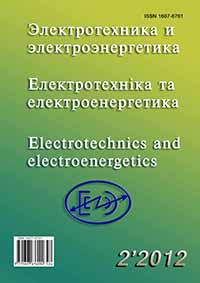Determination of the maximum value of the switching frequency IGBT module
DOI:
https://doi.org/10.15588/1607-6761-2012-2-4Keywords:
module IGBT, power loss, switching frequency, junction temperatureAbstract
An algorithm for the calculation of the maximum switching frequency of IGBT modules in the two-level voltage inverter mode, constant or cyclic loads, is proposed. The junction temperature of the IGBT does not exceed the maximumallowable value. The factors influencing the maximum allowed switching frequency of IGBT is considered.
References
MiniSKiiP Generation II Technical Explanations [Электронный ресурс] = Техническое описание второго поколения модулей MiniSKiiP / Musamettin Zurnaci / Semikron – Электронные данные (1 файл). [August 2012] – Режим доступа: http://www.semikron.com/skcompub/de/MiniSKiiP_11. pdf свободный, – Загл. с экрана.
Иванов-Смоленский, А. В. Электрические машины: учебник для вузов. В двух томах. Том 1 – М. : Издательский дом МЭИ, 2006. – 652 с.
Applying IGBT [Электронный ресурс] = Применение IGBT / Bjorn Backlund, Raffael Schnell, Ulrich Schlapbach, Roland Fischer, Evgeny Tsyplakov / ABB Semiconductors – Электронные данные (1 файл). – Switzerland [2009] – Режим доступа: http://www05.abb.com/global/scot/scot256.nsf/veritydisplay/2f1b6e7c0b7832ebc12575ae002691b6/$file/5sya2053-03%20applying%20igbts.pdf свободный, – Загл. с экрана.
Глава 11. АВТОНОМНЫЕ ИНВЕРТОРЫ [Электронный ресурс] / – Электронные данные (1 файл). – [2009?] – Режим доступа: http://epa.susu.ac.ru/assets/files/PromElectronika/Glava11_Pt.pdf свободный, – Загл. с экрана.
Херманн, Ральф SKiiP 4 – новая серия IPM для применений высокой мощности / Ральф Херманн, Андрей Колпаков // Силовая Электроника. – 2009. – № 4. – С. 14–18.
Downloads
How to Cite
Issue
Section
License
Copyright (c) 2017 V. S. Ostrenko

This work is licensed under a Creative Commons Attribution 4.0 International License.
Creative Commons Licensing Notifications in the Copyright Notices
Authors who publish with this journal agree to the following terms:
Authors retain copyright and grant the journal right of first publication with the work simultaneously licensed under aCreative Commons Attribution License that allows others to share the work with an acknowledgement of the work's authorship and initial publication in this journal.
Authors are able to enter into separate, additional contractual arrangements for the non-exclusive distribution of the journal's published version of the work (e.g., post it to an institutional repository or publish it in a book), with an acknowledgement of its initial publication in this journal.
Authors are permitted and encouraged to post their work online (e.g., in institutional repositories or on their website) prior to and during the submission process, as it can lead to productive exchanges, as well as earlier and greater citation of published work.

